Antoine Watteau died of consumption in 1721. He was 36: ‘an inauspicious age fatal to the art of painting,’ observed one of his many memorialists, the art collector Antoine de la Roque (he was thinking of the fates of Raphael and Eustache Le Sueur, who died at a similar age). Once it emerged from the shadows cast by the muscular neoclassical productions of Jacques-Louis David and his acolytes in the years around the Revolution, Watteau’s work came to be suffused with this aura of youth too soon snuffed out. In their history of 18th-century French art, published between 1873–80, the brothers Jules and Edmond de Goncourt spent time on Watteau’s most celebrated productions, his fêtes galantes. To their eyes, these paintings of aristocratic merrymaking in bucolic settings addressed ‘modern love, poetic love, love that dreams and thinks’. Like their maker, they appeared possessed by what the English physician Benjamin Marten, in his 1720 treatise on consumption, had characterised as the ‘sadness and very great anxiety of mind’, typically experienced by the consumptive. Watteau himself, meanwhile, seemed to have suffered from a kind of accelerated ageing (‘an old man of 30, with sunken eyes and shrunken lips’). The Goncourts’ interpretation was no doubt helped along by their own historical position, their consciousness of what Watteau himself could not have known: that the world of the fêtes galantes would soon be swept away.

The Scale of Love (c. 1717–18), Antoine Watteau. National Gallery, London
These readings have been eyed with increasing suspicion in recent years, but Watteau does seem to have been peculiarly interested in the artistic implications of time. Though not necessarily melancholic, his fêtes galantes are inherently time-bound. The figures that populate them repose (for a moment) in playgrounds away from the workaday world. They enjoy transient pleasures: dancing, singing, conversation. Paintings such as La Finette in the Louvre and The Scale of Love in the National Gallery in London zoom in on the harmonies produced by strumming singers, taking as their subject music unheard (by us), and quick to fade. But nowhere in his oeuvre is this preoccupation clearer than in a series of seven etchings Watteau produced at the beginning of his career, showing four men (one now lost) and three women modelling the fashions of the 1710s.
Fashion-focused engraving was a newly reinvigorated genre in the first decades of the 18th century, when Paris was increasingly establishing itself as the centre of European style. In part its dominance reflected the success of the Mercure Galant, which had launched in 1672, and furnished its readers with detailed analyses of the latest fashions by the journalist Jean Donneau de Visé, and accompanying illustrations by Sébastien Leclerc. While Donneau de Visé offered guidance on trends from Versailles (men were still wearing large hats, he confirmed in the inaugural issue, but skirts were increasingly ornamented with gold and silver), Leclerc helped repopularise fashion as a subject for engraving. Over the next few decades, Leclercian images of fashionable figures emerged from the city’s print shops around the rue Saint Jacques. These included ‘fashion plate’ engravings, showing single figures (or, occasionally, small groups) in the most up-to-date court and city styles. As ephemeral as the width of the brim of a hat, they were popularised and proliferated by engravers including Claude Simpol and Bernard Picart, as well as artists such as Watteau, who were more familiar with other media.
Watteau both drew and (unusually for him) etched his fashion plates, which were lightly reworked by the engraver Simon Thomassin the Younger and published in c. 1710 as Figures de modes dessinées et gravées à l’eau-forte par Watteau et terminées au burin par Thomassin le fils. The inclusion of Watteau’s name in the title indicates that he was already familiar to the art market. During this period, the artist now celebrated as the painter of fêtes galantes was primarily working on decorative arabesques and theatrical and military scenes. According to another memorialist and (as he was careful to emphasise) friend, the art dealer Edmé-François Gersaint, Watteau had become ‘known by all connoisseurs’ after selling two paintings of soldiers to another dealer, Pierre Sirois, for 200 livres. However, the Figures de modes came at a transitional point in his career. Watteau had just left his master Claude Audran III, with whom he had been collaborating on interior schemes featuring monkeys and chinoiserie. Only a couple of years later, in 1712, he was formally invited to join the Royal Academy of Painting and Sculpture, after the board bent its rules and decreed he could be admitted solely on submission of a reception piece, a painting presented for approval.
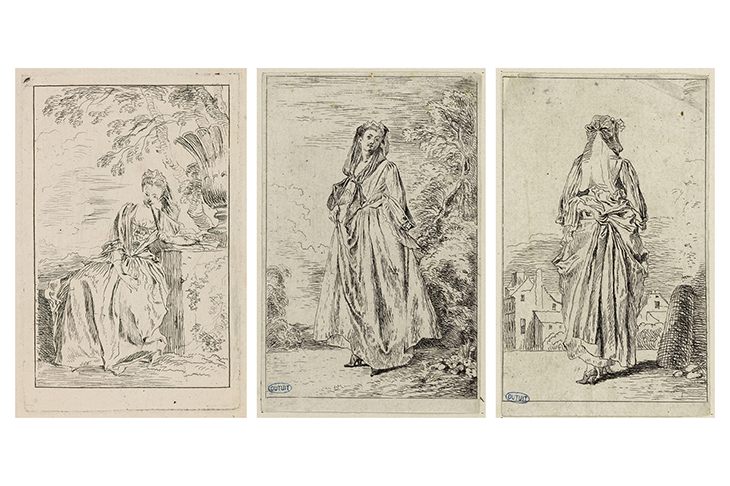
Les figures de modes (3 out of the 6 surviving subjects), (c. 1710), Antoine Watteau. Musée du Louvre, Paris (far left); Petit Palais, Paris. Photo (far left): Musée du Louvre, dist. RMN-Grand Palais/Angèle Dequier
The Academy’s invitation was an honour, but seems to have inspired no sense of urgency in the young artist, who painted some more theatrical scenes, and some of his new fêtes galantes. At some point (probably around 1715), he produced a second series of single-figure engravings, the Figures françoises et comiques. The elegantly attired men and women in this group, professionally engraved this time, were probably offcuts from the earlier Figures de modes. By 1717, the Academy had issued several formal reminders and was growing impatient. It gave Watteau an ultimatum and a six-month deadline. Apparently at last spurred into action, he finally presented it with one of the most significant paintings of the 18th century, Pilgrimage to the Island of Cythera. It is a difficult painting to define. It draws on the tropes of the fête galante, a genre which, before Watteau made it his own, had been characteristic of 17th-century Netherlandish artists, but its specific setting is mythological, and was well known from the contemporary stage. Cythera is the traditional island of Venus from which (as one playwright had it) ‘no young woman returns without a husband, or a young man without a wife’. The Academy did not concern itself with the nuances of the genre; it helped to cement Watteau’s burgeoning reputation for fêtes galantes by omitting its title altogether in their records, and marking it simply as ‘un feste galante’. Technical analysis of the painting, now in the Louvre, has confirmed it was executed at speed. There is evidence in abundance of Watteau’s tendency to use huge lashings of oil, on brushes he didn’t bother to clean, as a way of spreading the colour more effectively and (as Gersaint put it) of ‘ridding himself more quickly of a painting he was obliged to finish’.
The Figures de modes have a similar sense of immediacy about them, although this time the imperative was not a testy Academy, but the ever-evolving shapes of jackets and skirts. Watteau must have looked at key precedents in the genre, such as La Noblesse de Lorraine by Jacques Callot and Le Jardin de la noblesse françoise by Abraham Bosse, both from the 1620s. Of the two, Bosse is the more direct influence. Callot’s figures present themselves to the viewer as if to the portraitist, but the aristocrats of Bosse’s Noblesse françoise are invariably in motion. They draw a sword, mount a step, or turn towards us or away, and their movements are amplified by billowing cloth and swirling hair. Watteau’s figures, too, are dynamic. A young woman raises her skirt as if to dance; a man in profile pauses mid-promenade. The pose of the latter is borrowed almost wholesale from Bosse, but comparison underlines the differences. Where the aristocrat of the 1620s had looked about him with proprietorial pomposity, Watteau’s figure glances casually at a dozing village emerging from scrappy woodland. Bosse’s figure seems to have been rooted since time immemorial in the acres stretching out before him, and a corresponding sense of solidity is conveyed by the defined postures and detailed surroundings that characterise the series as a whole, and the heavy clothes indicated with firm lines. By contrast, Watteau’s print suggests a chance encounter with a world that has all the solidity of pasteboard. The man in profile and his companions wander through undisturbed outbuildings, occasionally leaning on nondescript plinths or fountains. The columns and plinths wander apart from the figures who lean on them; the lines that describe them are flighty and vague.

Les figures de modes (3 of the 6 surviving subjects) collected in the ‘Recueil Julienne’ and published in 1735, after Watteau. Art Institute of Chicago
As pure fashion plates, the Figures generally follow, rather than revise, the established format, and it is easy to imagine the expectant customer feeling frustration at the lack of detail. Donneau de Visé and the Mercure had provided gleeful, almost fetishistic, analyses of the nuances of lace, silk and style, but Watteau’s Figures merely imply the presence of a shirt or a shoe with hasty black lines. In 1748, long after Watteau’s death, another self-proclaimed friend and memorialist, the Comte de Caylus, delivered an obituary lecture at the Academy that went into some detail on the artist’s technique. No doubt with a warning eye trained on his student audience, and in formulations that sit strangely alongside the account offered by Gersaint, Caylus described Watteau’s exemplary work ethic. He explained what he considered the unfortunate dominance of lighter subjects in Watteau’s works by emphasising that his friend had ‘conceived of art on a plane far more elevated than the work he actually produced’. Watteau had also, he said, been particularly keen to study from life, since, having ‘no understanding of anatomy’, his execution was always inferior to his ideas.
Eager to emphasise Watteau’s Academic credentials, Caylus did not concern himself with the fashion plates. Had he done so, he would probably have seen them as further sorry evidence of Watteau’s technical shortcomings. He may have been right. The Figures are certainly anatomically incorrect. Their heads seem to float disembodied from large, triangular bodies, which twist and turn at improbable angles. One of the standing women has a neck positioned too far across one shoulder, and the man leaning on a pedestal holds all his weight in his elbows. This provisional quality may indeed be the result of their creator’s lack of technical confidence. Watteau returned to etching only once after this brief experiment, for his Recruits Going to Join the Regiment (c. 1715), a depiction of balletic soldiers who share a certain elegant carelessness with the fashion plates and retain what Horace Walpole identified as ‘the air of a nation that aspires to be agreeable as well as victorious’. This spontaneity also reveals Watteau’s tendency to dash things off. Gersaint observed that ‘he grew bored of anything he had in front of him for any length of time’, and spent his career ‘flitting from project to project’. This seems to have been a feature of his personality. In a famous description, Gersaint characterised his friend as ‘restless and changeable […] impatient, timid […] always unhappy with himself and others’.
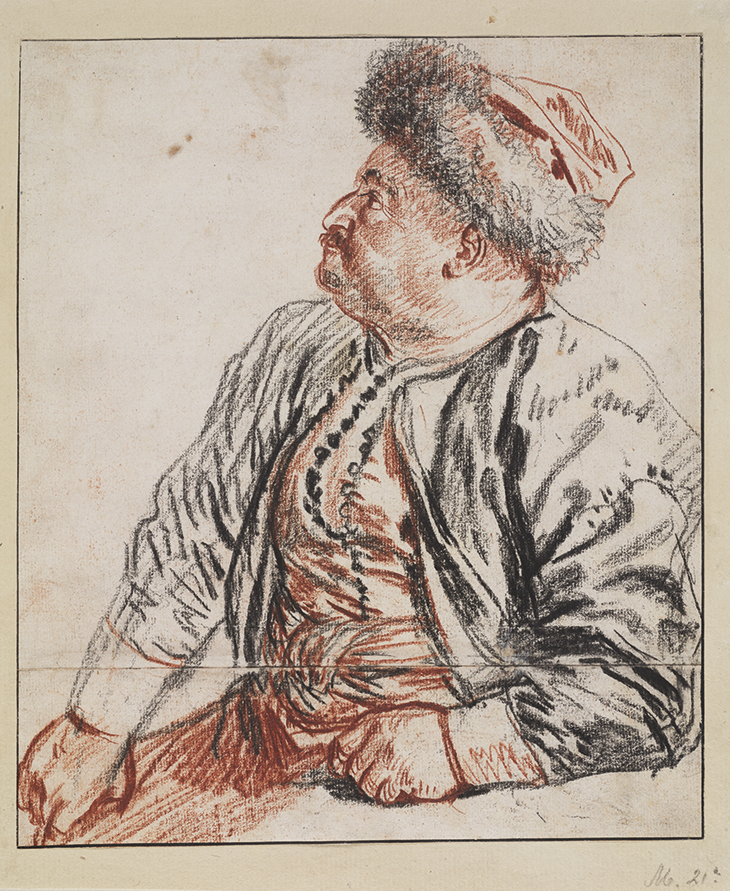
Seated Persian in Profile (c. 1715), Antoine Watteau. Teylers Museum, Haarlem
Whatever difficulties Watteau may have had with the etching needle, the Figures fully exploit the freedom of a medium which, of all printmaking techniques, comes closest to the spontaneity of drawing, the genre in which he undeniably excelled. A few years later, he produced a series of black and red chalk sketches that are similarly preoccupied with costume, and the virtuosic economy with which he delineates the sleeve of a middle-aged man in Persian dress demonstrates what he could do at full tilt. A similar air of spontaneity is the characteristic that most differentiates Watteau’s Figures de modes from fashion plates by earlier artists, and from his own later, professionally engraved Figures françoises. Like the fashions they depict, they feel temporary, even capricious, and they impart a similarly elegant abandon to the characters themselves. It is an effect entirely appropriate to prints designed primarily to circulate, and then vanish. It is also familiar to modern eyes. Contemporary fashion photography has a similar tendency to eschew the practical details of a buttonhole or a collar in favour of a general air of careless chic. In such images, calculated to spark emulation in those who view them, the clothes themselves are often a paradoxically understated afterthought.
After Watteau died, another art collector in his circle, Jean de Jullienne, commissioned a series of engravings from his works, gathering them together in a monumental two-volume publication, the Recueil Jullienne. The result, published between 1726–35, is one of the earliest catalogues raisonnés in the history of art. In the second volume, engravings based on the original Figures de modes drawn and etched by Watteau and retouched by Thomassin appear alongside a series of single-figure prints extracted from Watteau’s other drawings. That Jullienne felt able to conflate the two underlines the apparent continuity between the fashion plates and Watteau’s other productions, including the fêtes galantes. It also reflects the artist’s own approach to his drawings, which he seems to have used as a kind of image library, furnishing figures to which he might return for projects undertaken months, even years, later. The man standing at the crest of the hill in Cythera had previously also appeared in the Figures françoises; the woman toying with her fan under a tree was recycled from a sheet of three figure studies now in the Getty. Jullienne’s intentions in bringing these two groups together may not have been entirely pure; he seems to have been uncomfortable with Watteau’s commercial projects. In conflating the Figures de modes with his other drawings, the Recueil removed them from their original, ephemeral context, slowing them down and solidifying them. In the process, it repackaged Watteau as something closer to the careful student Caylus would describe in 1748.
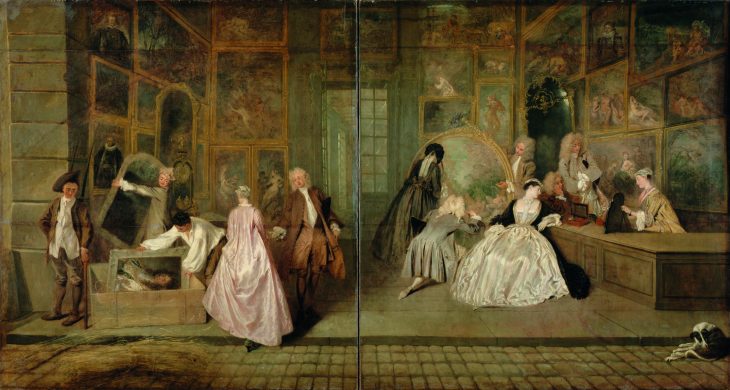
The Shop Sign of Gersaint (1720/21), Antoine Watteau. Stiftung Preussische Schlösser und Gärten Berlin-Brandenburg, Schloss Charlottenburg
Jullienne’s discomfort was apparently shared by Watteau’s other (predominantly bourgeois) memorialists, but not, it seems, by Watteau himself. He certainly did not abandon the kind of projects encapsulated by the Figures after he submitted Cythera to the Academy. His penultimate painting, The Shop Sign of Gersaint (1720/21), tells a similar story of speed and sprezzatura wrapped up in an explicitly commercial context. Supposedly begun ‘to keep the chill out of his fingers’, The Shop Sign was a kind of shop-warming present for the man whose name it now bears. Gersaint’s first dealership had recently burnt down, along with the rest of the Petit Pont on which it had stood, and the painting is an idealised depiction of the new one. Watteau intended it to hang outside, above the door (the elongated figures were designed to be viewed from below). From this position, it would invite the passer-by to follow the woman in pink across its threshold, and discover the delights for sale within. Gersaint’s account of the painting’s production repeats a common theme. ‘I was very reluctant to let him do it,’ he wrote, ‘preferring him to spend his time on something more worthwhile.’ In emphasising the idea that it was a jeu d’esprit, Gersaint hoped to downplay the painting’s commercial context, and its broader significance in Watteau’s body of work. He does seem to have hung it outside his shop, on the artist’s insistence, but it was back indoors within a few weeks. By the time of Watteau’s death, Gersaint – businessman to the bone – had already sold it on to the collector Claude Glucq.
Though Gersaint may have sought to obfuscate its context, The Shop Sign positively celebrates art for sale. It is an advertisement for Gersaint’s shop, but also for the artist’s talents, of his ability to adapt, and throw things together as required. The protean artist, Watteau declares, can paint both the elegant conversationalists at the heart of the picture and the faux Old Masters on the dealer’s walls. The painting also suggests a link between these two worlds, the fashionable and the commercial. The deportment and grace of the one is a (purchasable) product of the other. It is a more explicit connection than the one made by the Figures de modes, but cut from the same cloth. Indeed, the woman stepping into Gersaint’s shop is a cousin to the woman seen from behind in the early series. With this final piece of commercial art, Watteau looked back to his beginnings. Within a year of its completion, he was dead – and the memorialists began their work.
From the December 2019 issue of Apollo. Preview the issue and subscribe here.
Unlimited access from just $16 every 3 months
Subscribe to get unlimited and exclusive access to the top art stories, interviews and exhibition reviews.


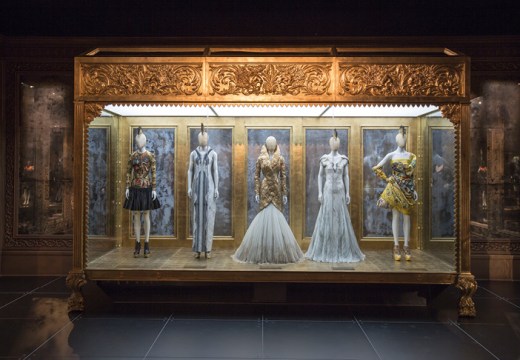
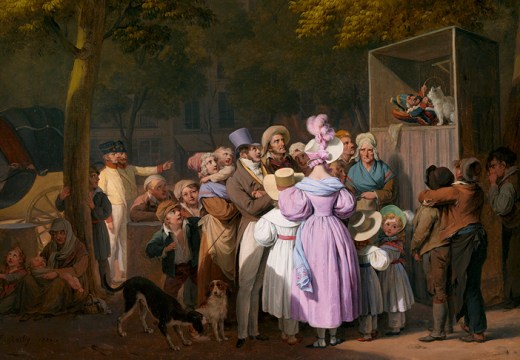
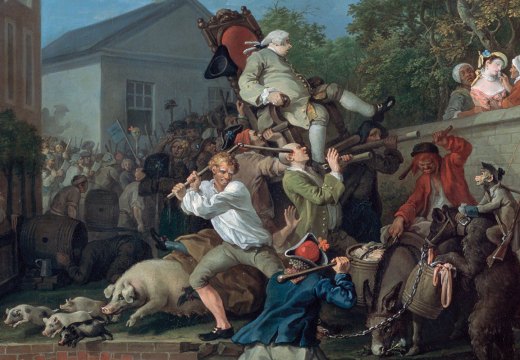









![Masterpiece [Re]discovery 2022. Photo: Ben Fisher Photography, courtesy of Masterpiece London](http://www.apollo-magazine.com/wp-content/uploads/2022/07/MPL2022_4263.jpg)
Has the Fitzwilliam lost the hang of things?